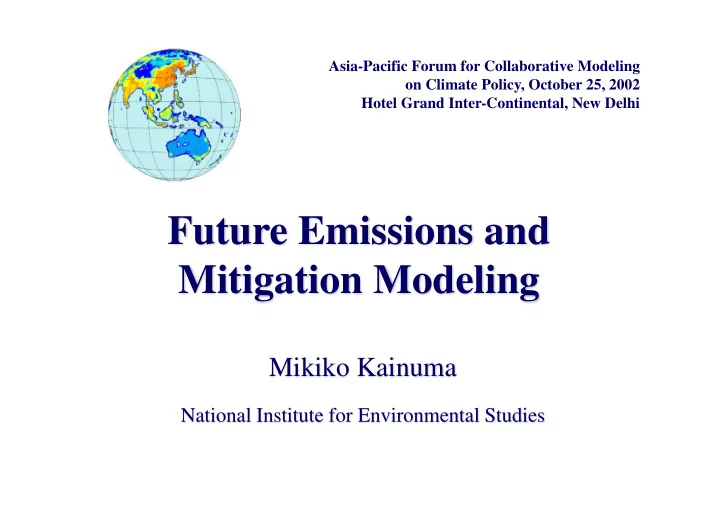

Asia-Pacific Forum for Collaborative Modeling on Climate Policy, October 25, 2002 Hotel Grand Inter-Continental, New Delhi Future Emissions and Mitigation Modeling Mikiko Kainuma National Institute for Environmental Studies
CO2 emission intensity Market 2032 Policy 1995 gC/m 2 /year 0 5 10 100 1000 2032
Japan million Oceania 4500 South East Asia 4000 East Asia 3500 Japan 3000 million Oceania South Asia 2500 South East Asia 5,000 2000 4,500 East Asia Asia-Pacific 4,000 1500 Western, Eastern, 3,500 South Africa 1000 South Asia America 3,000 500 2,500 Europe + CIS Asia-Pacific 2,000 0 Middle East + Western, Eastern, 1,500 South Africa 2000 Northern Africa 1,000 2015 America 2030 500 Europe + CIS - 2000 Population projection in Middle East + 2015 2030 Northern Africa Market First Scenario Population projection in Security First Scenario
Billion US$ 1995 Japan Oceania 50,000 South East Asia 45,000 40,000 East Asia 35,000 30,000 Billion US$ 1995 25,000 South Asia 20,000 50,000 Asia-Pacific Western, Eastern, 15,000 45,000 South Africa Japan 10,000 America 40,000 Oceania 5,000 Europe + CIS South East Asia 35,000 - Middle East +Northern Africa 2000 East Asia 30,000 2015 2030 25,000 South Asia World GDP in Market First Scenario 20,000 Asia-Pacific 15,000 W,E,S Africa America 10,000 5,000 Europe+CIS - Middle East +Northan Africa 2000 2015 2030 World GDP in Security First Scenario
8,000 Historical data 7,000 Market First Policy First 6,000 CO 2 emissions (Mt-C) Security First 5,000 Sustainability First 4,000 3,000 2,000 1,000 0 1980 1990 2000 2010 2020 2030 Year Energy related CO 2 emissions in the Asia-Pacific region
South Asia South Asia South Asia Afghanistan Afghanistan Afghanistan Bangladesh Bangladesh Bangladesh MK : Market First MK : Market First SC : Security First SC : Security First 300 300 India India India Bhutan Bhutan Bhutan PO : Policy First PO : Policy First SU : Sustainability First SU : Sustainability First Iran Iran Iran Maldives Maldives Maldives Nepal Nepal Nepal Pakistan Pakistan Pakistan Change in energy-related CO 2 emissions Change in energy-related CO 2 emissions 250 250 Sri Lanka Sri Lanka Sri Lanka Southeast Asia Southeast Asia Southeast Asia Brunei Brunei Brunei Cambodia Cambodia Cambodia by 2032 relative to 2002 (%) by 2032 relative to 2002 (%) Indonesia Indonesia Indonesia Lao Lao Lao 200 200 Malaysia Malaysia Malaysia Malaysia Myanmar Myanmar Myanmar Myanmar Philippines Philippines Philippines Singapore Singapore Singapore Thailand Thailand Thailand Vietnam Vietnam Vietnam 150 150 East Asia East Asia East Asia China China China Korea, Dem Korea, Dem Korea, Dem Japan Japan Japan Korea, Rep Korea, Rep Korea, Rep 100 100 Mongolia Mongolia Mongolia Taiwan, China Taiwan, China Taiwan, China Central Asia Central Asia Central Asia MK MK MK Kazakhstan Kazakhstan Kazakhstan Kyrgyz Republic Kyrgyz Republic Kyrgyz Republic PO PO PO SC SC SC SU SU SU 50 50 Tajikistan Tajikistan Tajikistan Turkmenistan Turkmenistan Turkmenistan Uzbekistan Uzbekistan Uzbekistan ANZ and South Pacific ANZ and South Pacific ANZ and South Pacific 0 0 Australia Australia Australia New Zealand New Zealand New Zealand MK MK MK MK MK MK MK MK MK MK MK MK PO PO PO PO PO PO SU SU SU SC SC SC SU SU SU PO PO PO SC SC SC PO PO PO SC SC SC SU SU SU SC SC SC SU SU SU Fiji Fiji Fiji Kiribati Kiribati Kiribati Nauru Nauru Nauru Palau Palau Palau -50 -50 Papua New Guinea Papua New Guinea Papua New Guinea French Polynesia French Polynesia French Polynesia ANZ and ANZ and South Asia South Asia South East Asia South East Asia East Asia East Asia Central Asia Central Asia Tonga Tonga Tonga Vanuatu Vanuatu Vanuatu South Pacific South Pacific Samoa Samoa Samoa Solomon Islands Solomon Islands Solomon Islands Change in energy related CO 2 emissions by 2032 relative to 2002 in sub-regions of the Asia-Pacific region
Japanese reduction and recovery of GDP caused by Kyoto (without international emission trade) 2005 2010 0 (comparison with baseline, trillion yen) -0.5 GDP loss caused by -1.0 Kyoto target GDP change Recovery by increased production of -1.5 environmental industry -2.0 -2.5 -3.0
Japanese reduction and recovery of GDP caused by Kyoto (without international emission trade) 2005 2010 0 (comparison with baseline, trillion yen) -0.5 GDP loss caused by -1.0 Kyoto target GDP change Recovery by increased production of -1.5 environmental industry Recovery by investment in advanced technology -2.0 development -2.5 -3.0
Japanese reduction and recovery of GDP caused by Kyoto (without international emission trade) 2005 2010 0 (comparison with baseline, trillion yen) -0.5 GDP loss caused by -1.0 Kyoto target GDP change Recovery by increased production of -1.5 environmental industry Recovery by investment in advanced technology -2.0 development Recovery by increasing environmental premium -2.5 of consumption -3.0
Estimates of CO 2 Emission in A A A A 1 2 2 1 Japan with AIM end-use model B B B B 1 1 2 2 < Countermeasure case > 1,600 CO 2 Emission (MtCO 2 ) 1,400 1,200 A1 1,000 A2 B1 B2 800 600 A1 102 105 A2 96 88 400 B1 98 87 B2 96 83 200 (1990=100) 0 1990 2000 2010 2020
Necessary reductions for stabilization assuming Business as Usual development path 40 Business 30 CO2 emissions as Usual ( GtC ) 20 10 650 ppmv 550 ppmv 450 ppmv 0 2050 2000 2100
Environmental 4.1 Innovations 3.6 for Cost 3.3 2.9 5.0 Reduction 1.9 4.0 2.3 2.3 0.9 3.0 0.9 0.3 2.0 0.6 1.2 0.4 1.2 0.0 1.0 0.3 0.0 0.0 0.0 0.0 0.0
Recommend
More recommend